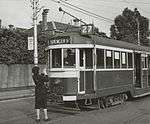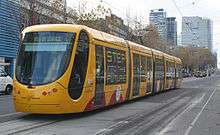Melbourne tram classification
Melbourne's tram classification system is based on classes originally devised by the Melbourne and Metropolitan Tramways Board.[1]:8 At first this was based on the order in which the original tramways companies had purchased the different types of tram between 1910 and 1921.[1]:8
The classification system was simplified in 1928.[1]:8 All the drop end combination trams: B, H, J, M and S classes were added to A class. The straight sill combination classes F, K, Q, and R, were added to G class. Maximum traction bogie combination classes D, E, N, and P, were added to C class. Sometimes variations on a design were given extra letters or numerals. For example, W class trams classified as W3 or CW5. Over the years many of the trams were modified and then reclassified. For example, all the W class trams were converted to W2 class between 1928 and 1933.[1]:23
Individual trams were also numbered by the tramways companies. In 1924 the MMTB unified the numbering across the fleet.[1]:8 With the introduction of Z class trams, the MMTB started a new numbering system.[1]:8 Tramways in Ballarat, Bendigo, Geelong, Sorrento and the Victorian Railways had their own tram numbering systems. Trams which were moved between the systems were renumbered.
There were also a large number of non-passenger trams, such as rail grinders, breakdown cars and freight cars which were not included in the classification system.
Classes
| M&MTB Tram Classification and Number | ||||
|---|---|---|---|---|
| Image | Class | Description | Fleet numbers | |
| A class | Single truck, drop end, open California combination, built by Duncan and Fraser (1910-1911) for PMTT[1]:49 | 1-20 | ||
| B class | Single truck, drop end, open California combination, built by Moore (1917-1918) for PMTT[1]:50 | 21-24, 84-91 | ||
| C class | Maximum traction, bogie, drop end and centre combination, built by Duncan and Fraser (1913) for PMTT[1]:51 | 25-35 | ||
| D class | Maximum traction, bogie, drop end and centre combination, built by Duncan and Fraser (1914) for PMTT[1]:51 | 36 | ||
| E class | Maximum traction, bogie, drop end and centre combination, built by Duncan and Fraser (1914) for PMTT[1]:52 | 36-45 | ||
| F class | Single truck, straight sill, clerestory-roofed, single aisle summer car, built by Duncan and Fraser (1912) for PMTT[1]:52 | 46-47 | ||
| G class | Single truck, straight sill, single aisle summer car, built by Duncan and Fraser (1913) for PMTT[1]:53 | 48-53 | ||
| H class | Single truck, drop end, open California combination, built by Duncan and Fraser (1913) for PMTT[1]:54 | 54-63 | ||
| J class | Single truck, drop end, open California combination, built by Meadowbank (1915) for PMTT[1]:54 | 64-83 | ||
| K class | Single truck, drop end, open California combination, built by Moore (1919-1920) for PMTT[1]:55 | 92-100 | ||
| L class | Bogie combination, built by Moore (1921) for PMTT[1]:56 | 101-106 | ||
| M class | Single truck, drop end, open California combination, built by Duncan and Fraser (1917) for HTT and FTT[1]:58 | 107-116, 183-189 | ||
| N class | Maximum traction, bogie, drop end and centre combination, built by Duncan and Fraser (1916) for HTT[1]:59 | 117-126 | ||
| O class | Maximum traction, bogie, straight sill, combination with one drop end, built by Duncan and Fraser (1912) for PMTT[1]:60 | 127-130 | ||
| P class | Maximum traction, bogie, drop end and centre combination, built by Duncan and Fraser (1917–18) for HTT[1]:61 | 131-138 | ||
| Q class | Single truck, straight sill, closed combination, built by MMTB (1922-1923)[1]:62 | 139-150, 190-201 | ||
| R class | Single truck, straight sill, closed combination, built by Moore (1920) for FNPTT[1]:63 | 151-153 | ||
| R class | Single truck, straight sill, closed combination, built by MMTB (1920)[1]:63 | 172-176 | ||
| S class | Single truck, drop end, open California combination built by Duncan and Fraser (1916-1922) for MBCTT and MMTB[1]:64 | 154-171 | ||
| T class | Single truck, drop end, open combination with long saloon, built by Duncan and Fraser (1917) for MBCTT[1]:65 | 177-182 | ||
 | U class | Single truck, saloon, built by Duncan and Fraser (1906) for NMETL[1]:66 | 202-211 | |
| V class | Single truck, open cross bench, built by Duncan and Fraser (1906) for NMETL[1]:67 | 212-216 | ||
 | W class | Bogie drop centre combination, built 1923-1927 by Holden, Moore and MMTB[1]:23:112 | 219-418 | |
| W1 class | Bogie drop centre combination, built by MMTB (1925-1928)[1]:25 | 419-438, 470-479 | ||
| W2 class | Bogie drop centre combination, built by MMTB and Moore (1927–31)[1]:26 | 439-458, 480-609, 624-653 | ||
| W3 class | Bogie drop centre combination, built MMTB (1930-1934)[1]:32 | 654-669 | ||
| W4 class | Bogie drop centre combination, built MMTB (1933-1935) | 670-674 | ||
| CW5 class | Maximum traction, bogie, drop centre combination, built MMTB (1934-1935)[1]:38 | 681-685 | ||
| W5 class | Bogie, drop centre combination, built by MMTB (1935-1939)[1]:35 | 720-839 | ||
| SW2 class | Bogie drop centre saloon, built by MMTB (1938, 1953, 1955)[1]:37 | 275, 426, 432, 436, 478, 644 | ||
 | SW6 class | Bogie drop centre saloon, built by MMTB (1939-1951)[1]:40 | 850-969 | |
| PCC class | Two door bogie saloon, built by MMTB (1950)[1]:42 | 980 | ||
.jpg) | W6 class | Bogie, drop centre saloon, built by MMTB (1951-1955)[1]:43 | 970-979, 981-1000 | |
.jpg) | W7 class | Two door bogie saloon, built by MMTB (1955-1956)[1]:42 | 1001-1040 | |
| W8 class | Bogie drop centre saloon, converted from SW6 trams 922 (1993), 946 (2012) and 959 (2013) | 1101, 946, 959 | ||
| X class | Single truck saloon safety car, built by Brill and St.Louis Car Co.(1923)[1]:22 | 217-218 | ||
| Y class | Bogie saloon, built by MMTB (1927)[1]:29 | 469 | ||
| X1 class | Single truck saloon, built by MMTB (1926-1928)[1]:28 | 459-468 | ||
| Y class | Bogie saloon, built by MMTB (1927)[1]:29 | 469 | ||
| X2 class | Single truck saloon, built by MMTB (1930)[1]:30 | 674 (later 680), 675-679 | ||
| Y1 class | Bogie saloon, built by MMTB (1930)[1]:31 | 610-613 | ||
 | Z1 class | Two door bogie saloon, built by Comeng (1974-1978)[1]:13 | 1-100 | |
 | Z2 class | Two door bogie saloon, built by Comeng (1978-1979)[1]:13 | 101-115 | |
| Z3 class | Three door bogie saloon, built by Comeng (1979-1984)[1]:16 | 116-230 | ||
| A1 class | Three door bogie saloon, built by Comeng (1983-1985) | 231-258 | ||
| A2 class | Three door bogie saloon, built by Comeng (1985-1987) | 259-300 | ||
| B1 class | Articulated saloon, built by Comeng (1984-1985)[1]:19 | 2001-2002 | ||
 | B2 class | Articulated saloon, built by Comeng (1987-1994) | 2003-2132 | |
_at_St_Vincents_Plaza%2C_on_route_109%2C_July_2005.jpg) | C1 class | Three-section articulated saloon, low floor Citadis 202 tram, built by Alstom(2001-2002) | 3001-3036 | |
 | C2 class | Five-section articulated saloon, low floor, Citadis 302 trams built by Alstom (2008)[2] | 5103, 5106, 5111, 5113, 5123 | |
| D1 class | Three section, low floor Combino trams, made by Siemens (2002-2003)[3] | 3501–3538 | ||
_in_Elizabeth_St_on_route_19_to_City_in_PTV_livery%2C_December_2013.jpg) | D2 class | Five section, low floor Combino trams, made by Siemens (2003–2004)[4] | 5001–5021 | |
| E class | Three-section, four-bogie articulated trams built by Bombardier Transportation (2013-)[5] | 6001–6050 | ||
References
- 1 2 3 4 5 6 7 8 9 10 11 12 13 14 15 16 17 18 19 20 21 22 23 24 25 26 27 28 29 30 31 32 33 34 35 36 37 38 39 40 41 42 43 44 45 46 47 48 49 Cross, Norman (2001). Destination City. Sydney: Transit Australia. ISBN 0 909459 17 7.
- ↑ "C2 Class, VICSIG - Trams". vicsig.net. 2013. Retrieved 31 December 2013.
- ↑ "D1 class, VICSIG - Trams". vicsig.net. 2013. Retrieved 31 December 2013.
- ↑ "D2 class, VICSIG - Trams". vicsig.net. 2013. Retrieved 31 December 2013.
- ↑ "E class, VICSIG - Trams". vicsig.net. 2013. Retrieved 31 December 2013.